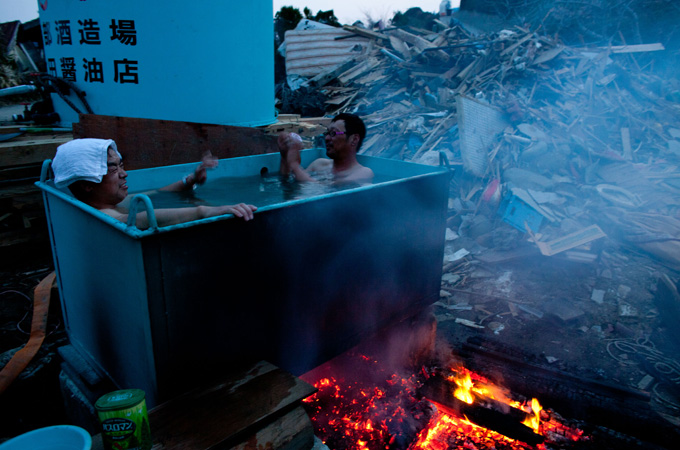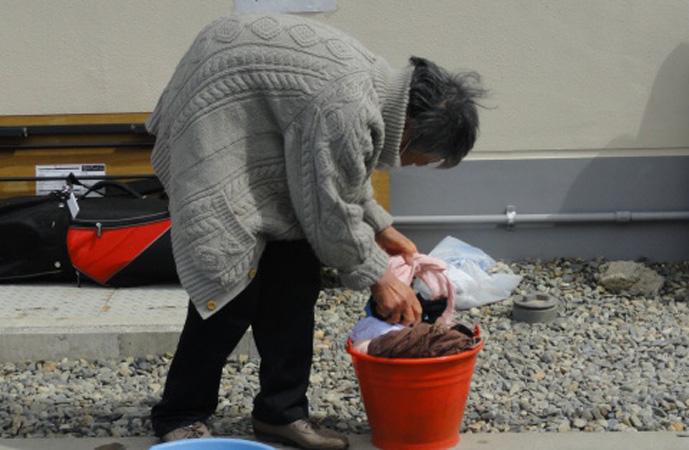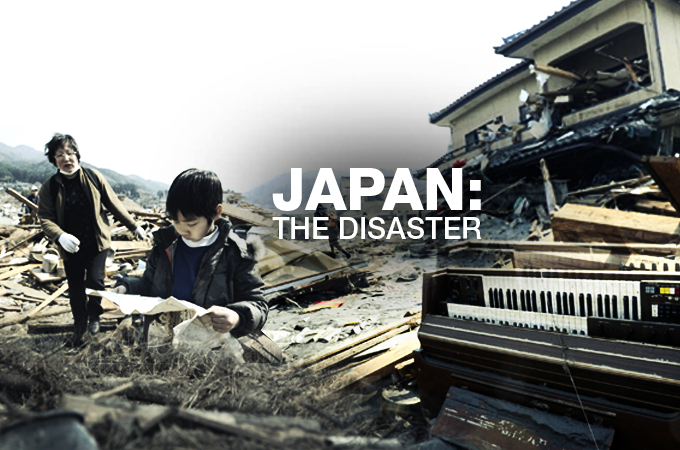Aftershocks compound Japan’s nuclear woes
Locals strive for steady nerves as stressed crust rumbles on and radiation leaks from a damaged nuclear plant.

 |
| A month after the tsunami, Miyagi residents remain without basic services and are left to bathe among the ruins [AFP] |
Hundreds of aftershocks have rocked the ground and frayed nerves in the five weeks since Japan’s massive earthquake and tsunami, forcing survivors to relive the terror almost daily.
The incessant rumbling of the Earth’s stressed crust including yet another powerful aftershock on Saturday – has held back relief work, imperilled already dangerous operations to contain a nuclear crisis and fuelled fears far beyond the coast that was devastated by the giant wave.
Keep reading
list of 4 itemsTurtles swimming to extinction in Malaysia as male hatchlings feel heat
Could shipping containers be the answer to Ghana’s housing crisis?
Thousands protest against over-tourism in Spain’s Canary Islands
Many now plain of a queasy sensation where they feel that the ground is swaying beneath their feet even when it is not – a condition blamed on confused inner-ear balance receptors and a heightened state of anxiety.
For the tens of thousands living in evacuation shelters and near the tsunami wastelands, the creaking of already weakened buildings and the risk of another killer wave spark mortal fears.
“We are almost getting used to the aftershocks, yet every time one of them strikes, we are reminded of the terror we felt the day of the tsunami,” said Kenichi Endo, 45, who lost his fisherman father at sea to the monster wave.
He is one of 790 people holed up in an elementary school turned evacuation centre in the Miyagi prefecture.
 |
| Over 130,000 remain in shelters, where laundry is done by hand in buckets in the bitterly cold outdoors [D. Parvaz] |
Even those who did not lose their homes remain rattled over a month after the twin disasters.
Misaki Sanada, a 29-year-old resident of Ibaraki prefecture, about 123km north of Tokyo, told Al Jazeera that while she is accustomed to earthquakes, she was never scared of them until the big one hit last month.
“Recently, earthquakes originating in Ibaraki are happening a lot, so it makes me think another very big earthquake could happen soon around here,” said Sanada, who works for a relocation company in Tokyo.
In the capital too, millions are put on edge every time a shrill seismic early-alert tone sounds on TV or their mobile phones, warning of a fresh threat.
Sanada said that every time a major aftershocks hit, the schedule of most trains are disrupted, prompting a sense of panic as people leave work early in an effort to get home.
“With this situation we still have to go to work as usual, with regular hours, as if nothing happened, and that makes me quite stressed out, and question the way our society is,” she said.
Since the 9.0-magnitude quake shifted the seafloor by 24mand sent a huge wave crashing into Japan, more than 400 quakes above magnitude 5.0 have hit, most below the sea but many beneath Japan itself.
Geophysicists agree that the jolts and rumbles will not stop any time soon, but they only differ on whether they will go on for months or years.
At the Onagawa evacuation centre, the lights went off after an April 7 aftershock, and hundreds poured out of the buildings until the tremors subsided and they were allowed back inside.
Kiyoto Abe, a town official, said that “the aftershocks are adding another layer of stress for evacuees. In neighbouring towns, I’ve heard evacuation centres were damaged by the aftershocks and needed to relocate to other areas”.
Nuclear crisis continues
Aftershocks centred near the damaged Fukushima nuclear plant have also repeatedly forced emergency crews there to evacuate, and led to fears the charred reactor buildings and water pipes may be further compromised.
In video footage shot on April 12, a water sample-collecting vessel is seen being lowered into reactor No 4 and towards the water in the cooling pool.
 |
Still, Sanada and other sources have told Al Jazeera that they do not rely on information released by Tokyo Power Electric Company (TEPCO), the operator of the damaged nuclear plant, for information.
Instead, they rely on Twitter, television news and magazines.
Engineers have been pumping fresh water into the pools inside the four reactors in an attempt to keep fuel rods from overheating after the March 11 earthquake knocked out pumps and generators which had kept the water circulating inside the reactors.
Japan’s Nuclear and Industrial Safety Agency (NISA) has said a new plan for cooling reactor No 2, located 240km northeast of Tokyo, may be needed due to the large volume of highly radioactive water on site, and tests would be done to determine if damaged fuel rods were emitting radiation via the suppression pools.
NISA has also said it was now “highly likely” there was a hole in the suppression unit of the reactor. Engineers are also concerned that some spent fuel rods were damaged by the earthquake and could be emitting high levels of radiation.
“This seems to be a confirmation of what people have assumed since the first week,” Tony Roulstone, the course director of the nuclear energy graduate programme at the University of Cambridge, told Al Jazeera.
He is not, however, sure why engineers have gone from assuming this to be the case to saying it is now “highly likely”.
“We’re not getting good information,” said Roulstone, pointing to TEPCO as a poor source of information for the public. Still, he said that what this pseudo-confirmation of damage to the outer containment wall – likely caused by pressure created from over-heated fuel rods – means is that engineers might have found the source of the highly radioactive water found in the trenches on site.
Japan’s nuclear crisis has been rated on par with the world’s worst nuclear crisis at Chernobyl in 1986, although the total amount of radiation released is only a fraction of that when the nuclear plant in Ukraine exploded.
The government has expanded a 20km evacuation zone around the plant because of high accumulated radiation. No radiation-linked deaths have been reported, and 21 plant workers have been affected by minor radiation sickness.
Additional reporting by D. Parvaz. Follow her on Twitter @dparvaz.